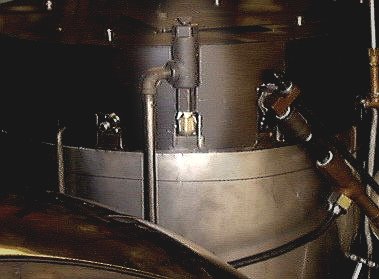
safety (pop) valve located at the left
front of the boiler
| SAFETY (POP) VALVE | |

safety (pop) valve located at the left
front of the boiler |
The pressure safety relief valve or pop valve is a safety device that limits the steam pressure in the boiler. If for some reason the steam automatic fails to shut the burner fuel flow off when the boiler is at operating steam pressure the safety valve opens to relieve the excess steam being generated. When a Stanley has been blown-down and put away the boiler will siphon full of water. If the car is moved and throttle valve is closed, the water pumps will try and push additional water into the boiler that is already full (normally after a boiler has siphoned full of water the water automatic bypass valve is opened allowing the water from the pumps to flow back to the water supply tank). The piston water pumps will quickly build hydrostatic pressure in the boiler and if the pop valve doesn’t operate to relieve the excess water pressure damage to the boiler, pumps, and/or boiler piping may occur. Whenever a Stanley is to be moved, making sure both the water automatic bypass valve and the throttle should be opened to provide two means for hydrostatic pressure to be released from the boiler. |
|
HOW A SAFETY VALVE WORKS |
|
|
A Pop-valve consists of a disc with two areas, closing on a single seat; the lower area of the disc protrudes through the seat. The horizontal surface starting at "Edge B" represents the seat. For the purposes of this discussion assume the upper part of the disc is 1-1/4 square inches in area, and the lower part, or protruding part is 1 square inch in area. The disc is held down by a heavy spring that applies 600 pounds of force on the disk. A screw allows the pressure of the spring to be adjusted and thus changes the pressure at which the valve operates. Assume the boiler is at 602 PSIG that means there’s 602 pounds of steam pressure applied to the bottom of the valve. We then have 602 PSIG per square inch pushing up on the 1 square inch of area and 600 pounds of spring pressure pushing down. The valve disk starts to rise and relieve pressure from the boiler. The valve is now said to be "throttling" or "feathering". Steam will be racing past the tapered part of the seat at Lip A. However the conical section that is formed at this part of the valve body and seat only relieves the pressure acting on the 1 square inch of area of the valve seat such that the disk only rises enough to allow a small amount of steam to escape. This effectively lowers the pressure operating against the 1-1/4 square inch disk so it doesn’t see the full force of the 602 PSIG steam against it. Now if we continue to raise the boiler pressure to o say 605 PSIG. The steam rushing past Edge B will be restricted such that the full boiler pressure will still build against the 1-1/4 square inch disk. Then the disc will start to rise until Lip "A" gets a lot closer to Edge B which means the steam can flow past the conical area and exert its full force against the 1-1/4 square inch surface of the valve disk. When this happens there is 605 PSIG pressure operating on 1-1/4 square inches and the upward thrust is 756.25 pounds. The downward spring force is only 600 pounds so the valve pops wide open. With the valve wide open the boiler pressure drops based on how fast the valve can dump steam pressure from the boiler. The valve disk will be held off the seat due to the pressure against it from the boiler steam and the flow velocity of the steam past the valve disk. After a short period of time the boiler pressure will have dropped to 480 PSIG. We then have a little less than 480 pounds steam pressure pushing up on the disk, but a full 600 pounds of spring pressure pushing down. With 480 PSIG steam pressure pushing on the 1-1/4 square inch disk the thrust of the steam is now only 600 pounds, which allows the spring to start pushing the disk down onto the seat. As the pressure drops the velocity of the steam also is reduced through the conical section of the valve seat and doesn’t assist in keeping the valve disk open. The valve disk starts to close. Then we have 480 PSIG steam pressure applied to the 1 square inch disk pushing up and 600 pounds of spring pressure pushing down and the valve quickly shuts off with no throttling or feathering action. We have lowered the boiler’s steam pressure from 600 PSIG down to 480 PSIG. So the blowdown or blowback is 120 PSIG in this case |
pop valve seated
pop valve feathered
pop valve blowing |